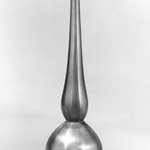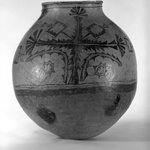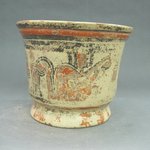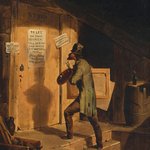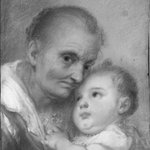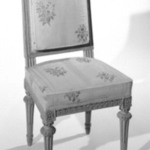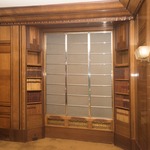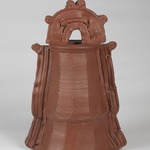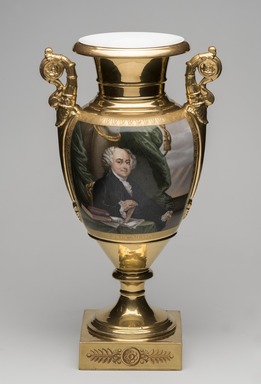
Vase, One of a Pair, John Adams
Decorative Arts and Design
Depicted on this vase by an unknown French maker is John Adams, the second president of the United States and an ardent supporter of the antislavery movement. Although George Washington and subsequent American presidents utilized slave labor in their households, Adams rejected the practice and instead hired and compensated white and free Black workers for their labor.
MAKER
Unknown
MEDIUM
Porcelain, overglaze enamel, gilt
DATES
ca. 1826–1830
DIMENSIONS
17 1/2 x 9 1/2 x 7 in. (44.5 x 24.1 x 17.8 cm) (show scale)



COLLECTIONS
Decorative Arts and Design
ACCESSION NUMBER
47.19.1
CREDIT LINE
Museum Collection Fund
CATALOGUE DESCRIPTION
One of pair of Sevres vases, Empire form, porcelain, gold ground with portrait on one side, conventional design of banding with medallion on opposite side, scroll handles, square base with circle and leaf decoration. Portrait of John Adams seated at table with green curtains in background.
Condition: Good
EXHIBITIONS
MUSEUM LOCATION
This item is not on view
CAPTION
Unknown. Vase, One of a Pair, John Adams, ca. 1826–1830. Porcelain, overglaze enamel, gilt, 17 1/2 x 9 1/2 x 7 in. (44.5 x 24.1 x 17.8 cm). Brooklyn Museum, Museum Collection Fund, 47.19.1. Creative Commons-BY (Photo: Brooklyn Museum, 47.19.1_PS11.jpg)
IMAGE
overall, 47.19.1_PS11.jpg. Brooklyn Museum photograph, 2020
"CUR" at the beginning of an image file name means that the image was created by a curatorial staff member. These study images may be digital point-and-shoot photographs, when we don\'t yet have high-quality studio photography, or they may be scans of older negatives, slides, or photographic prints, providing historical documentation of the object.
RIGHTS STATEMENT
Creative Commons-BY
You may download and use Brooklyn Museum images of this three-dimensional work in accordance with a Creative Commons license. Fair use, as understood under the United States Copyright Act, may also apply.
Please include caption information from this page and credit the Brooklyn Museum. If you need a high resolution file, please fill out our online application form (charges apply).
For further information about copyright, we recommend resources at the United States Library of Congress, Cornell University, Copyright and Cultural Institutions: Guidelines for U.S. Libraries, Archives, and Museums, and Copyright Watch.
For more information about the Museum's rights project, including how rights types are assigned, please see our blog posts on copyright.
If you have any information regarding this work and rights to it, please contact copyright@brooklynmuseum.org.
RECORD COMPLETENESS
Not every record you will find here is complete. More information is available for some works than for others, and some entries have been updated more recently. Records are frequently reviewed and revised, and we welcome any additional information you might have.










